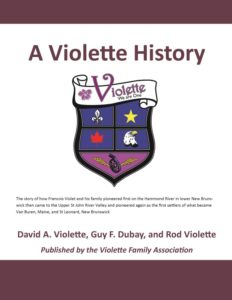
A Violette History, published by the Violette Family Association
It has been over three years since A Violette History was published – have you ordered your copy yet? It is available on Amazon. Just search for the book title. Book sales proceeds go to the Association. This was a major work authored by David A. Violette (VFA #621), Rod Violette (VFA #12), and Guy Dubay (VFA #892). The book traces the history of François Violet/Violette (1744-1824), acknowledged as the progenitor of our Violette family in North America. It covers the period from his grandparents in France through his own life in France, Fortress Louisbourg, New Brunswick, and Maine.
The following excerpt is from Chapter 13 – François Moves To Madawaska Settlement and sets the stage for why and how Francois and Marie-Luce left the Lower St John River valley and moved to pioneer new lands in what is now Van Buren ME and St Leonard NB along the Upper St John River.
Francois [1] {6} and Marie-Luce {759} had lived on their “hideaway on the Hammond” for at least 15 years when their lands passed from French title to British title around 1786. These were the lands on which they had settled, cleared, built, raised a family of (at that time) ten children, and made many improvements. In that long time, life must have settled into a routine of following the seasons and the tides of family. François was a teenager when he left Louisbourg and a young man of 26 when he married Marie-Luce in 1770. Now, he was 42 and probably considered himself well-established on his land and in his place. The title to his land, however, was granted under the French establishment and so was in question when it came under the British. He and his neighbors had thought that their move to Hammond River took them out of sight and out of mind of the British pre-Loyalists who were flooding into the area along the St John River, as we reported in Chapter 12. During and after the American Revolution the area further became a target for the Loyalists who were leaving the lower colonies in droves, especially after the British defeat and the American independence. As reported in the last chapter, François was awarded Lot #14 in 1787.
François and his family found themselves with new neighbors, none of whom shared their heritage, language, religion, and culture. These new neighbors were English-speaking, non-Catholic, British subjects. François had pledged allegiance to the British Crown in order to avoid deportation to France and to be able to hold lands (Ed Note: See the petition by François on page 15 in Chapter 12, where reference is made to his taking an Oath), but was only able to hold title to his lands with the help of two influential Loyalists. Edward Winslow and Ward Chipman took up the cause of the Acadians and obtained from the government the restoration of some of their property. That Francois did not receive all his property back is indicated by the petition shown in Chapter 12, dated 28th August 1786.
When the French in the Ste. Anne (Fredericton) area and other settlements along the St John River were forced to move north to the Madawaska Settlement in June of 1785, the fifteen French families along the Hammond River at French Village did not follow. They were finally granted deeds to their lands on April 12, 1787, having been on those lands since about 1768. However, when the lands were granted under the British, the lots were assigned so that Loyalists were interspersed with the Acadian settlers. While these families probably felt comfortable where they were, having spent almost 20 years of toil improving their property, they soon became uncomfortable being increasingly a minority in the region.
But by 1789 there were other pressures on François and Marie-Luce. Their children were growing older and would soon need lands of their own to settle on and develop. By now they had twelve children living with them, and quarters must have been cramped, to say the least. We know nothing about their house and how large it was or if they had to keep expanding it, but certainly any house they built when they first started living there in 1760 would have become too small several times over! The oldest was Marguerite (19) and the youngest was Alexandre, 3 months old. In between were Augustin (17), Genevieve (16), François-Xavier (15), Charles (14), Louis (10), Marie Anne (9), Madeleine (8), Dominique (6), Benoni (4), and Marie Venerande (2).
From a different point of view, the New Brunswick government was anxious to have settlements in the upper St John River valley as a way to improve and secure a communication route with Québec. In addition, the Governor of New Brunswick did not wish to rid himself of the Acadians and did not want to lose them to the Province of Québec. He knew the Acadians were anxious to establish settlements where they could exercise their Catholic religion and Québec was beckoning to them to come there. By granting them lands within his province he succeeded in more than one desire. (Ref: Papers of Prudent Mercure, Tome 2, page 16)
So, on August 28, 1789 some French settlers along the Hammond River petitioned for grants of land in an unspecified portion of the upper St. John River; see Appendix 13-A. On December 21, 1789 another request was made, this time for lands below the original Mazerolle Concession; see Appendix 13-B. And on December 24, 1789 this second request was granted. We don’t know why the second petition was necessary, but it contained much more detail and covered many more points than the first so we have to assume that the petitioners had been advised to enhance their petition by adding these points. The petitioners became part of what was called the Soucy Concession.

